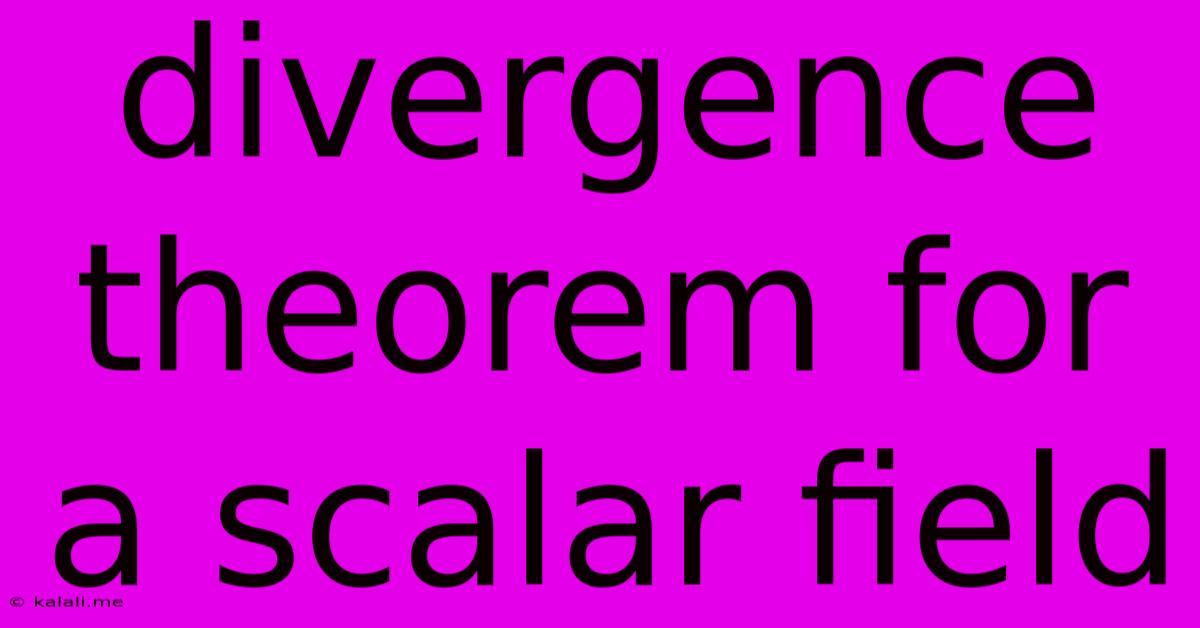Divergence Theorem For A Scalar Field
Kalali
May 23, 2025 · 3 min read

Table of Contents
Divergence Theorem for a Scalar Field: A Comprehensive Guide
The divergence theorem, also known as Gauss's theorem, is a fundamental concept in vector calculus that relates a surface integral of a vector field to a volume integral of its divergence. While commonly applied to vector fields, it can also be adapted for scalar fields, albeit with a slight modification in interpretation. This article provides a comprehensive explanation of the divergence theorem for a scalar field, its implications, and practical applications.
Meta Description: Understand the Divergence Theorem applied to scalar fields. This guide explains the theorem, its applications, and provides practical examples for a deeper understanding of vector calculus.
Understanding the Divergence Theorem for Vector Fields
Before delving into the scalar field application, let's briefly review the divergence theorem for vector fields. For a continuously differentiable vector field F defined on a volume V enclosed by a closed surface S, the theorem states:
∫∫<sub>S</sub> F ⋅ dS = ∭<sub>V</sub> ∇ ⋅ F dV
This equation signifies that the flux of the vector field F across the closed surface S is equal to the volume integral of the divergence of F over the volume V enclosed by S. The divergence (∇ ⋅ F) measures the outward flow of the vector field at a point.
Adapting the Theorem for Scalar Fields
Applying the divergence theorem directly to a scalar field isn't immediately intuitive since scalar fields don't have a direct concept of "flux." However, we can adapt the theorem by considering the gradient of a scalar field. The gradient of a scalar field, denoted as ∇φ, where φ is the scalar field, is a vector field. This vector field points in the direction of the greatest rate of increase of the scalar field, and its magnitude represents the rate of change.
Therefore, we can apply the divergence theorem to the gradient of a scalar field:
∫∫<sub>S</sub> (∇φ) ⋅ dS = ∭<sub>V</sub> ∇ ⋅ (∇φ) dV
This equation states that the flux of the gradient of a scalar field φ across the closed surface S equals the volume integral of the Laplacian of φ (∇ ⋅ (∇φ) = ∇²φ) over the volume V. The Laplacian (∇²φ) is a scalar quantity that measures the second-order spatial derivatives of φ. It represents the concavity or curvature of the scalar field.
Interpreting the Results
The result of the volume integral, ∭<sub>V</sub> ∇²φ dV, gives us information about the overall distribution of the second-order derivatives of the scalar field within the volume V. A positive value indicates a net positive curvature (e.g., a local maximum within the volume), a negative value indicates a net negative curvature (e.g., a local minimum), and a value of zero suggests a relatively flat distribution within the volume.
Practical Applications
The divergence theorem for scalar fields finds applications in various fields, including:
-
Physics: Solving Laplace's equation and Poisson's equation in electrostatics and heat transfer. The Laplacian appears directly in these equations, allowing us to relate surface integrals to volume integrals and simplifying problem-solving.
-
Engineering: Analyzing fluid flow and heat distribution in complex geometries. Understanding the distribution of scalar quantities like temperature or pressure is crucial for optimization and efficient design.
-
Image Processing: Smoothing and filtering images using Laplacian operators. The Laplacian highlights areas of rapid change, aiding in edge detection and feature extraction.
Conclusion
The divergence theorem, though primarily associated with vector fields, extends its applicability to scalar fields by focusing on their gradient. This adaptation allows us to relate surface integrals of the gradient to volume integrals of the Laplacian, providing valuable insights into the distribution and curvature of scalar fields. Understanding this extension enhances problem-solving capabilities in various scientific and engineering disciplines.
Latest Posts
Latest Posts
-
What Voltage Is A Car Battery
May 24, 2025
-
How To Stop Birds Flying Into Windows
May 24, 2025
-
Do 2 Trades Per Month On F1 Visa
May 24, 2025
-
Why Is My Smoke Detector Chirping
May 24, 2025
-
Why Did Jacob Wrestle With God
May 24, 2025
Related Post
Thank you for visiting our website which covers about Divergence Theorem For A Scalar Field . We hope the information provided has been useful to you. Feel free to contact us if you have any questions or need further assistance. See you next time and don't miss to bookmark.